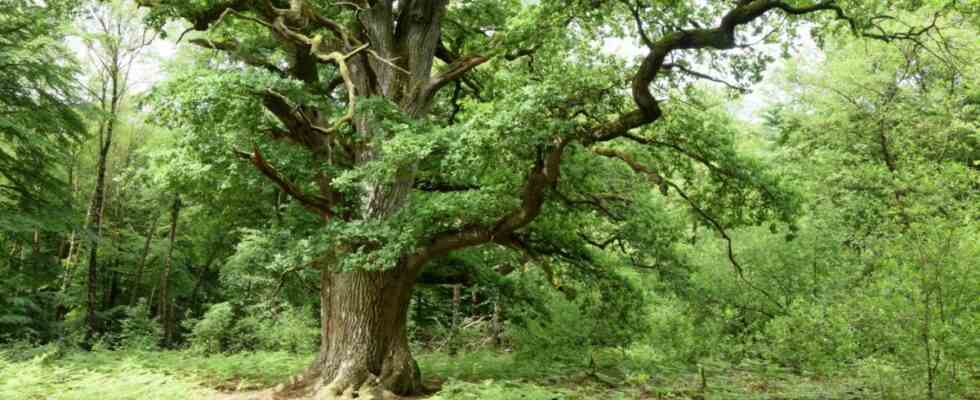The summer was very hard for Barbara Ernwein and her foresters. “It has hardly rained since the beginning of March,” says the head of the Ebrach state forest enterprise. “From July, the soil here in the Steigerwald was so dry that the beeches lacked water.” And then the heat. August was four degrees hotter in the Steigerwald than the long-term average. The consequences for the extensive deciduous forests were dramatic: from mid-July the leaves of the beech trees turned their autumn color prematurely and fell off shortly afterwards.
“This went across all age groups,” reports Ernwein, “young beeches are just as affected as middle-aged and ancient ones in the natural forest reserves.” This is astonishing insofar as the foresters assumed not long ago that beech trees in particular can cope well with heat and drought and thus with the climate crisis.
The other regions in Franconia, the Spessart for example, fared no better. Also in Upper Bavaria, where significantly more rain has fallen this year than in the north of the Free State, you can see beech, birch, linden, maple and other deciduous trees everywhere on the roadsides and in the forests, whose foliage has been turning yellow for weeks, as in autumn. reddish colored and completely dried up hanging on the branches. The phenomena are the same as in the dry years 2003, 2015 and 2018 to 2020. In some places, the trees have even shed their green leaves.
“The drought came too quickly and too severely this year”
“The drought came too quickly and too severely this year,” says Lothar Zimmermann from the State Institute for Forestry and Forestry (LWF). The immediate shedding of the leaves was apparently the only way for many trees to stop evaporation and not dry up completely. They would not even have had the time to withdraw nutrients and valuable minerals from the leaves.
The latter has consequences far beyond the past hot summer. “If the withdrawal of nutrients and minerals cannot take place completely, the tree will lack them in the following year,” says Zimmermann. Phosphorus and potassium, nitrogen and magnesium, which are stored in the bark and roots in normal years, are particularly affected. The leaf litter from the prematurely fallen leaves decomposes on the ground over the years, but the nutrients in it can be reabsorbed by the roots of the trees. “But that means an effort for the trees,” says Zimmermann.
Oak trees benefit from their deep taproots
The premature dropping of the leaves also reduces the energy reserves of the trees. “Fewer leaves means less photosynthesis,” says Zimmermann. “And that means less energy and growth.” Studies by the LWF have shown that tree growth has slowed down significantly in the past hot years in the Bavarian dry regions. “The protective function of deciduous trees against acute thirst leads to them starving in the following years,” says Zimmermann.
So far, the only native deciduous tree species that is comparatively resistant to all these phenomena is the oak. Zimmermann and other scientists predict that it will be significantly more stable in the climate crisis than the beeches.
Forest manager Ernstein also observes that the oaks in the Steigerwald are coping better with the current hot summer than the beeches. “They benefit from their strong and deep taproots,” she says. “In this way, they reach deep layers of soil that carry water for much longer, but can no longer reach the beeches.” Ernstein and her foresters care for and support the oaks in the Steigerwald. But the beeches will not give up under any circumstances. “Because the young beeches that are now growing back are used to heat and drought from an early age,” she says. “They will be much more resistant to this than their predecessors.”
The black pine is used to the Mediterranean climate. But in Bavaria, the trees that were planted around 1880 in the district of Würzburg are mostly damaged. A fungus is to blame.
(Photo: Heiko Becker/dpa)
But it might turn out differently. Because the increasingly severe dry and hot periods are now even affecting tree species that still have the reputation of being able to withstand the climate crisis. The black pine, for example, which is distributed from eastern Spain through southern France, large parts of central and southern Italy, the Balkans to western Turkey. The northernmost natural black pine forest is in the Austrian Wienerwald. The black pine is actually considered a beacon of hope for the local forests. Now three quarters of the trees in Bavaria’s largest black pine forest near Erlabrunn (Würzburg district) are damaged or dead. The trees were planted by humans around 1880. The reason for their current death is a fungus that thrives particularly well in dry weather. “The situation makes me very concerned,” says forester Wolfgang Fricker.
Fricker actually wants to convert the black pine forest in Erlabrunn into a mixed forest. Such attempts have often not been successful so far. Also, not all locals like the idea. The black pine forest, with its soft coniferous soil and smell, exudes a Mediterranean atmosphere that many like very much. Now there is new hope. Black pine is not the same as black pine. Experts have found that the Calabrian black pine and the Corsican black pine are better equipped to deal with the climate crisis than the Austrian black pine, which is particularly common in this country. Thousands of Corsican and Calabrian black pines are now being planted in Lower Franconia.

